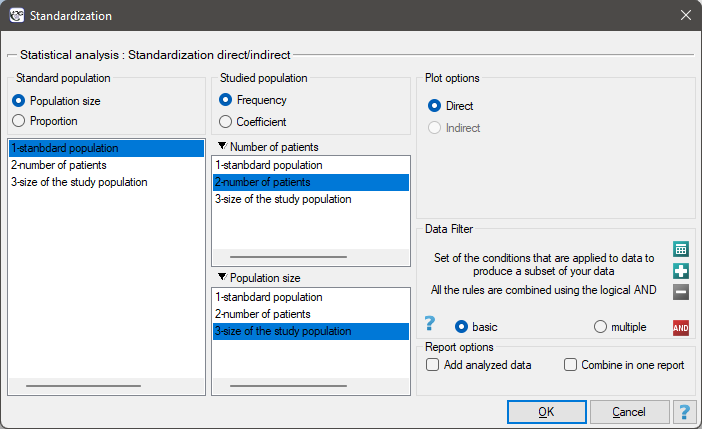Narzędzia użytkownika
Narzędzia witryny
Pasek boczny
en:statpqpl:usepl:arkpl:stanposrbezposrpl
Direct and indirect standardization
 We bring up the direct and indirect standardization window for epidemiological coefficients via
We bring up the direct and indirect standardization window for epidemiological coefficients via Data→Standardization…

Indirect and direct standardization applies to frequency coefficients, e.g. prevalence rates. Direct comparison of raw rates between different populations, usually living in different geographical areas and differing in factors that may influence the rates (e.g. age), may hide the differences. In order to remove the influence of population structure on these confounding characteristics, comparisons can be made using standardized coefficients. Standardization offers a mechanism to „filter out” the influence of a known confounding factor (e.g. age) and makes standardized coefficients obtained from different populations comparable. A necessary step in the process of standardizing coefficients is the selection of a standard population. The standard population for a population occupying a certain geographical area at a certain time may be a population covering a larger geographical area, including the study area, e.g. if the study population is the population of Wielkopolska voivodeship, the population of Poland may be used as a standard population. It is also possible to select a completely different population, geographically distant from the study population. However, it is advisable that the population chosen should be the reference population not only for the study in hand, but also for many other researchers. This is because it gives the opportunity to compare the results of studies using the same standard population. When choosing a population, it is recommended to pay attention to several aspects of the selection, such as:
- if several populations are being compared, a shared standard population minimizes the variance (variability) of the resulting standard coefficients;
- in trend analysis, the recommended standard population is the one that represents the average structure for the analysed time period;
- the standard population should be as similar as possible to the studied population;
- the same standard population should be consistently chosen to ensure comparability of studies (choosing a different standard population than the one commonly used means that all historical data would have to be recalculated).
Age and gender are the most commonly used characteristics for standardization, however, the standardization can also be based on other, arbitrary characteristics, which due to their obvious impact on the phenomenon should be „filtered out” from the study. Such features are called disturbing or confounding features. When choosing a characteristic for which we want to standardize, it should be remembered that standardization will be possible if we have sufficient information about the distribution of that characteristic in the population under study and in the standard population (Table 1). In addition, standardization by selected trait, e.g., by age, compensates to some extent for the influence of other age-related confounding factors, such as lifestyle, and standardization by gender compensates for those factors that are gender-related, such as occupation. The compensation of other factors is thus an important aspect in the selection of the trait against which standardization is performed.
Types of standardization:
- direct standardization – the standardized prevalence rate obtained with this method gives what the prevalence of the disease would look like in the study population if it had the structure (e.g., age structure) of the reference population;
- indirect standardization – the standardized prevalence rate obtained with this method gives an indication of what the prevalence of a disease in the study population would look like if the prevalence of the disease in the study population were the same in particular categories (e.g. age categories) as in the reference population.
en/statpqpl/usepl/arkpl/stanposrbezposrpl.txt · ostatnio zmienione: 2022/02/11 18:01 przez admin
Narzędzia strony
Wszystkie treści w tym wiki, którym nie przyporządkowano licencji, podlegają licencji: CC Attribution-Noncommercial-Share Alike 4.0 International

